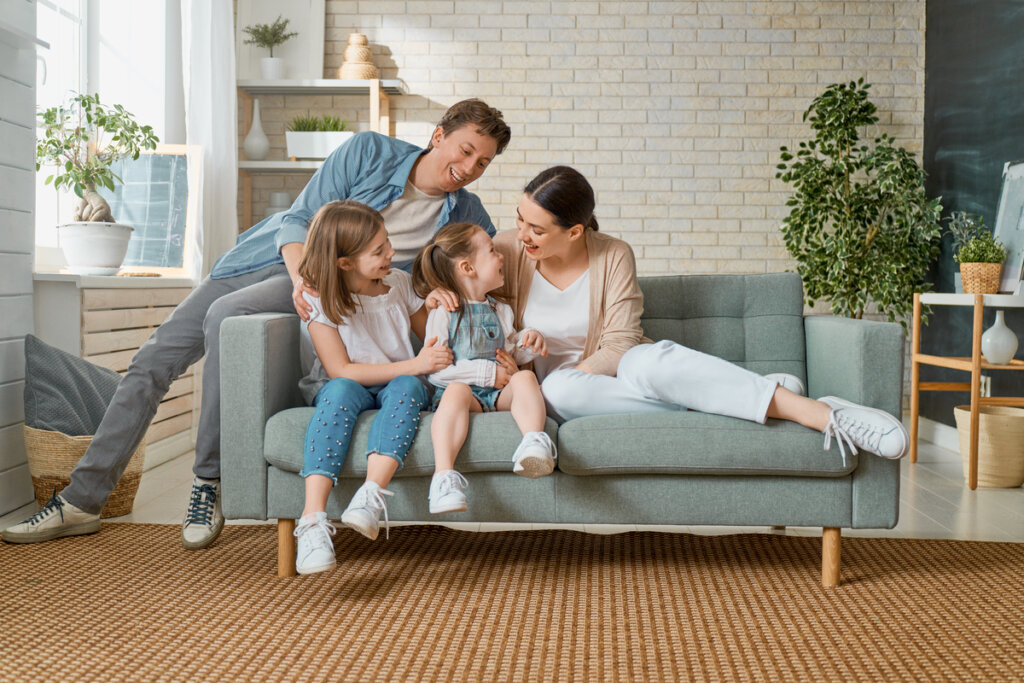What Makes a House a Home?


Written and verified by the psychologist Valeria Sabater
Your life is full of sensations and experiences that you don’t always know how to define. One of them involves the physical space that ends up being your home. It doesn’t matter if it’s owned or rented. Sometimes, something almost magical happens in the exhausting search for a place to live.
You cross a certain threshold, look around you, and, without really knowing why you feel at home. “This is it!” -you announce- certain that you’ll be happy within those four walls. It’s a sensation halfway between the emotional and the intuitive because you can’t really specify in detail what makes you feel that way.
The same thing can happen in other places that don’t belong to you. Indeed, there are times when, spending time in a hotel, or a friend’s or relative’s house, you feel as comfortable as if it were your own home. It’s as if you have a deep connection with that physical space and what’s in it. So, how are these feelings explained? What makes a house a home?
Environmental psychologists study individual’s relationships with the physical environments in which they live.

What makes a house a home?
One expression that’s more or less universal to all languages is “Home, sweet home”. However, as we all know, not all homes are sweet or happy. There are certain dynamics, experiences, and elements inside each house that determine the well-being of its inhabitants and, consequently, their attachment to these environments.
A luxurious and comfortable setting doesn’t necessarily make a house a home either. In fact, the process of emotional connection to a house involves a series of variables that environmental psychology has been studying for decades. It’s a fascinating subject.
The University of Minnesota (USA) published an interesting article on their website written by the geographer, Yi-Fu Tuan concerning how people construct the concept of ‘home’. He claims that our homes are the places where we yearn to have both protection and freedom at the same time. In these concrete refuges, we protect ourselves from the outside, feel free, and are able to fully be ourselves. In other words, we can take off the masks.
So, what factors really make a house a home? Read on to find out.
What you most need from a home is to feel safe and fulfilled in it.
1. The versions of yourself you see in your house
This is a really interesting approach and is well worth considering. Hazel Markus is a social psychologist at Stanford University (USA). She formulated the theory of our ‘selves’ being linked to a given context. For example, when you’re looking at apartments for rent and suddenly you find one you like because you’ve projected yourself into that space.
You imagine yourself in this home playing multiple roles and being what you want to be. You visualize yourself resting, working, cooking, and spending time with your family and friends in it. That’s because your home is the space in which you develop as a person in all your different versions.
2. A place where your needs are met
Living in an unhealthy house with a great deal of environmental noise, in which there’s hardly any natural light doesn’t cover your most basic needs. Such a context creates restlessness and unhappiness. On the contrary, finding a quiet property, well located, light and airy, and in good condition, generates completely different sensations in you.
You need the scenario you call home to cover all your needs, both the basic kind and those related to self-realization. At the end of the day, a house is a space where you want to stay and grow.
3. Places that evoke other houses where you were happy
Perhaps it’s the color of the walls, the view from the windows, or even the smell of the environment. There are houses that, like people, remind us of other houses where we were happy. We all have a certain attachment to past homes. Maybe you fondly remember that house your grandmother lived in, the one you lived in when you were little, or the one you used on vacation.
Sometimes, it’s enough to appreciate a minor detail to experience that same feeling. The one that tells you you’re in a secure, stimulating, and warm environment.
4. Your belongings also create your home
Your home won’t really be ‘yours’ until you fill it with your own belongings. That’s because inanimate objects also build who you are. You’re attached to them and they leave an imprint of who you are in a physical setting.
In addition, when you decorate your house according to your own taste and style, it becomes a reflection of your identity. After all, your home reflects your mind, personality, and experiences. That’s why you need to fill the walls with your paintings and photographs, the shelves with your books, and the rooms with those pieces of furniture that define you.
A house is a setting that you give life and character to when you decorate it in accordance with your own identity.

5. Your house is defined by who lives in it
A house is like an entity with a life of its own. You give life to it the moment you make it yours, taking care of it, giving it affection, filling it with your belongings and the sound of your daily life. But often, for a space with four walls to be your real home, you need the people you love.
Your family, friends, and even your pets are the ones that give your home the emotional imprint that makes it truly yours. Sometimes, it doesn’t even matter where you are. In fact, if you’re with the people you love, a cabin can become a palace and an apartment of a few square meters a five-star hotel.
In any house, it’s your emotions that paint the walls and your well-being that lays the carpets. That’s what makes it really feel like home.
Your life is full of sensations and experiences that you don’t always know how to define. One of them involves the physical space that ends up being your home. It doesn’t matter if it’s owned or rented. Sometimes, something almost magical happens in the exhausting search for a place to live.
You cross a certain threshold, look around you, and, without really knowing why you feel at home. “This is it!” -you announce- certain that you’ll be happy within those four walls. It’s a sensation halfway between the emotional and the intuitive because you can’t really specify in detail what makes you feel that way.
The same thing can happen in other places that don’t belong to you. Indeed, there are times when, spending time in a hotel, or a friend’s or relative’s house, you feel as comfortable as if it were your own home. It’s as if you have a deep connection with that physical space and what’s in it. So, how are these feelings explained? What makes a house a home?
Environmental psychologists study individual’s relationships with the physical environments in which they live.

What makes a house a home?
One expression that’s more or less universal to all languages is “Home, sweet home”. However, as we all know, not all homes are sweet or happy. There are certain dynamics, experiences, and elements inside each house that determine the well-being of its inhabitants and, consequently, their attachment to these environments.
A luxurious and comfortable setting doesn’t necessarily make a house a home either. In fact, the process of emotional connection to a house involves a series of variables that environmental psychology has been studying for decades. It’s a fascinating subject.
The University of Minnesota (USA) published an interesting article on their website written by the geographer, Yi-Fu Tuan concerning how people construct the concept of ‘home’. He claims that our homes are the places where we yearn to have both protection and freedom at the same time. In these concrete refuges, we protect ourselves from the outside, feel free, and are able to fully be ourselves. In other words, we can take off the masks.
So, what factors really make a house a home? Read on to find out.
What you most need from a home is to feel safe and fulfilled in it.
1. The versions of yourself you see in your house
This is a really interesting approach and is well worth considering. Hazel Markus is a social psychologist at Stanford University (USA). She formulated the theory of our ‘selves’ being linked to a given context. For example, when you’re looking at apartments for rent and suddenly you find one you like because you’ve projected yourself into that space.
You imagine yourself in this home playing multiple roles and being what you want to be. You visualize yourself resting, working, cooking, and spending time with your family and friends in it. That’s because your home is the space in which you develop as a person in all your different versions.
2. A place where your needs are met
Living in an unhealthy house with a great deal of environmental noise, in which there’s hardly any natural light doesn’t cover your most basic needs. Such a context creates restlessness and unhappiness. On the contrary, finding a quiet property, well located, light and airy, and in good condition, generates completely different sensations in you.
You need the scenario you call home to cover all your needs, both the basic kind and those related to self-realization. At the end of the day, a house is a space where you want to stay and grow.
3. Places that evoke other houses where you were happy
Perhaps it’s the color of the walls, the view from the windows, or even the smell of the environment. There are houses that, like people, remind us of other houses where we were happy. We all have a certain attachment to past homes. Maybe you fondly remember that house your grandmother lived in, the one you lived in when you were little, or the one you used on vacation.
Sometimes, it’s enough to appreciate a minor detail to experience that same feeling. The one that tells you you’re in a secure, stimulating, and warm environment.
4. Your belongings also create your home
Your home won’t really be ‘yours’ until you fill it with your own belongings. That’s because inanimate objects also build who you are. You’re attached to them and they leave an imprint of who you are in a physical setting.
In addition, when you decorate your house according to your own taste and style, it becomes a reflection of your identity. After all, your home reflects your mind, personality, and experiences. That’s why you need to fill the walls with your paintings and photographs, the shelves with your books, and the rooms with those pieces of furniture that define you.
A house is a setting that you give life and character to when you decorate it in accordance with your own identity.

5. Your house is defined by who lives in it
A house is like an entity with a life of its own. You give life to it the moment you make it yours, taking care of it, giving it affection, filling it with your belongings and the sound of your daily life. But often, for a space with four walls to be your real home, you need the people you love.
Your family, friends, and even your pets are the ones that give your home the emotional imprint that makes it truly yours. Sometimes, it doesn’t even matter where you are. In fact, if you’re with the people you love, a cabin can become a palace and an apartment of a few square meters a five-star hotel.
In any house, it’s your emotions that paint the walls and your well-being that lays the carpets. That’s what makes it really feel like home.
All cited sources were thoroughly reviewed by our team to ensure their quality, reliability, currency, and validity. The bibliography of this article was considered reliable and of academic or scientific accuracy.
- Hinds, Joe; Sparks, Paul (2008-06-01). “Engaging with the natural environment: The role of affective connection and identity”. Journal of Environmental Psychology. 28 (2): 109–120. doi:10.1016/j.jenvp.2007.11.001
- Simpson, J. A. & Rholes, W. S. (Eds.) (1998). Attachment Theory and Close Relationships. New York: Guilford Press.
- Tuan, Yi-Fu (1977). Space and Place. Minneapolis and London: University of Minnesota Press.
This text is provided for informational purposes only and does not replace consultation with a professional. If in doubt, consult your specialist.







